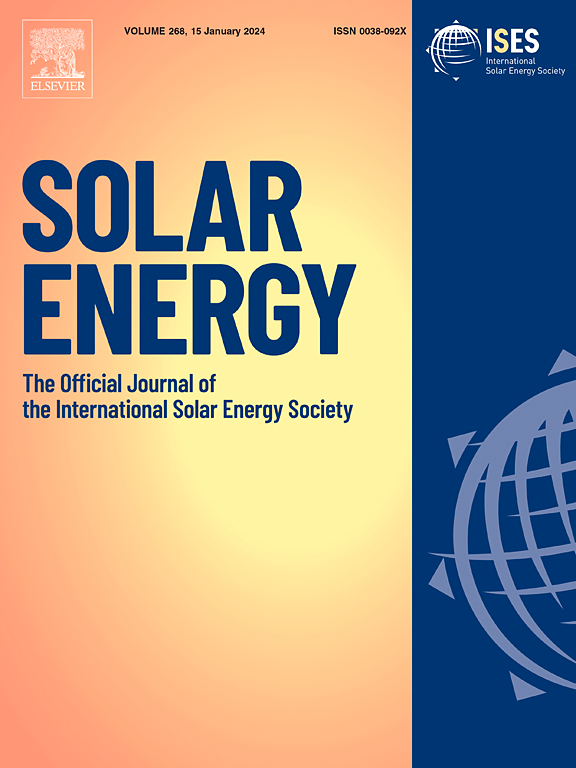卡尔曼滤波器在菲律宾大马尼拉地区 WRF-Solar预报后处理中的应用
IF 6
2区 工程技术
Q2 ENERGY & FUELS
引用次数: 0
摘要
根据部署在菲律宾大马尼拉市马尼拉观测站(MO;14.64°N,121.08°E)的高温计对 2020 年 1 月至 3 月(JFM)和 6 月至 8 月(JJA)两个季节的全球水平辐照度(GHI)进行了评估。使用高温计 GHI 测量的晴空探测方法,不仅可以验证整体预报性能,还可以分别验证多云和晴空时段的预报性能。为了改进 GHI 预报,使用卡尔曼滤波器(KF)对 WRF-太阳 GHI 值进行了后处理,测试了不同的训练天数(即从 3 天到 42 天),以确定最小均方根误差的最佳训练天数。KF 后处理的训练期最短(3 天),已将 MBE(RMSE)降低了 70% 至 94%(8% 至 12%)。滤波 WRF-Solar GHI 预报的最佳训练期(JJA 为 14 天;JFM 为 42 天)可使多云时段的 MBE(RMSE)至少减少 64%(17%)。然而,KF 低估了晴天时段的 GHI 值,因为减少了该站点上空多云时段的偏差。该研究是首次评估菲律宾上空 WRF-Solar 和 KF 性能的同类研究,其结果将作为计算效率高的替代方案的基础,以替代更昂贵的高分辨率和多成员集合太阳预报。考虑到辐照度数据的可用性,未来的工作打算侧重于将该方法应用于菲律宾的不同地形。本文章由计算机程序翻译,如有差异,请以英文原文为准。
Application of Kalman filter for post-processing WRF-Solar forecasts over Metro Manila, Philippines
Day-ahead forecasts of global horizontal irradiance (GHI) from WRF-Solar were evaluated against GHI observations from a pyranometer deployed at Manila Observatory (MO; 14.64°N, 121.08°E), Metro Manila, Philippines for the January to March (JFM) and June to August (JJA) seasons in 2020. A clear sky detection method using the pyranometer GHI measurements is employed to enable forecast validation not just for overall performance but also for cloudy and clear sky periods separately. To potentially improve GHI forecasts, the WRF-Solar GHI values were postprocessed using a Kalman filter (KF) tested for different training days (i.e., from 3 to 42 days) to determine the optimal number of training days that minimize the RMSE. KF post-processing, with the shortest number of training periods (3 days), already provides an MBE (RMSE) reduction of 70 to 94 % (8 to 12 %). The optimal training period (14 for JJA; 42 for JFM) for filtered WRF-Solar GHI forecasts leads to an MBE (RMSE) reduction of at least 64 % (17 %) during cloudy periods. However, KF underestimates GHI values for clear sky periods because of reducing the bias of the dominantly cloudy periods over the site. Results from the study, the first of its kind to assess performance of WRF-Solar and KF over the Philippines, will serve as a basis for a computationally efficient alternative to more expensive higher resolution and multiple ensemble member solar forecasts. Future work intends to focus on applying this method over different topographies in the Philippines, given the availability of irradiance data.
求助全文
通过发布文献求助,成功后即可免费获取论文全文。
去求助
来源期刊

Solar Energy
工程技术-能源与燃料
CiteScore
13.90
自引率
9.00%
发文量
0
审稿时长
47 days
期刊介绍:
Solar Energy welcomes manuscripts presenting information not previously published in journals on any aspect of solar energy research, development, application, measurement or policy. The term "solar energy" in this context includes the indirect uses such as wind energy and biomass
 求助内容:
求助内容: 应助结果提醒方式:
应助结果提醒方式:


